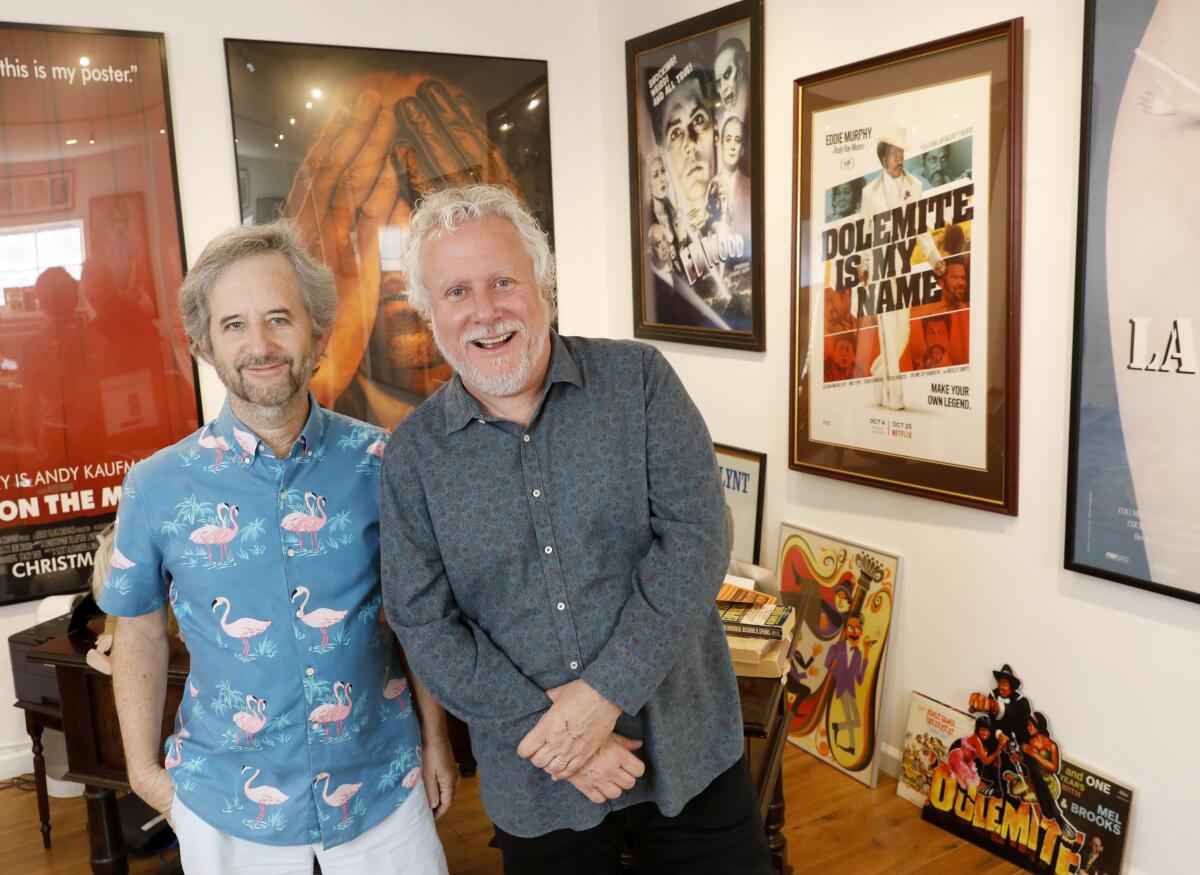‘Dolemite’ is funny and wild. It also sends a very real — and current — message

At one point in “Dolemite Is My Name,” the screenwriter insists that his creative projects have “to inform as well as entertain.” This was also our personal mission with our script for the film. On the surface, it is a rowdy, joke-filled love letter to low-budget filmmaking. But it’s also an in-depth look at segregation in Hollywood.
Because they couldn’t get past the gatekeepers, performers of color were forced to create a separate showbiz world. We wanted to teach audiences about this forgotten, recent history. But it was a long journey to get here.
Sixteen years ago, we got a message that Eddie Murphy wanted to meet us. We were giddy, since we were huge fans (and who isn’t?). When we arrived at his office, Eddie immediately started performing dialogue from our film “Ed Wood,” imitating Tor Johnson and Bela Lugosi. Our minds were blown. Then he smiled.
“Do you guys know who Rudy Ray Moore is?” We both started laughing — oh, yes we knew. In college in the ‘80s, we were obsessed with Rudy, watching his VHS tapes and listening to his albums. And now Eddie wanted to play Rudy, which was perfect. A legend playing a legend. We always try to write movies we want to see, and this was one we would be first in line for.
Eddie waved his magic wand, and days later we were in a room with the real Rudy Ray Moore. Yes, Rudy arrived as Dolemite, loud and full of bluster. Rudy was a larger-than-life persona, and he saw his life as myth. He told us his story and how it could translate into film. But as he talked, he softened. We could see the real man underneath.
The years of struggle had taken a toll on him. Dolemite wasn’t who Rudy Ray Moore was ... he was a do-anything character Rudy created in order to succeed. And he still hadn’t given up. That’s why we called the movie “Dolemite Is My Name” — because it is about a vulnerable man living with his heroic creation.
Eddie Murphy, director Craig Brewer, and the cast and writers of “Dolemite Is My Name” on the legacy of Rudy Ray Moore
But, sadly, we couldn’t get a studio to take the project. They saw it as too fringe. The language was too strong. They didn’t understand how sweet we could make it. Years went by. Rudy passed away in 2008. We felt terrible because we had promised him we would tell his story. We put together a tribute evening at the American Cinematheque, and Rudy’s screenwriter Jerry Jones, cinematographer Nicholas von Sternberg, and “Dolemite” composer Ben Taylor participated. It was beautiful.
More years passed. We heard talk that other people wanted to do Rudy’s story or remake “Dolemite,” but it never happened. Then we created the television miniseries “The People v. O.J. Simpson.” That show became a sensation, and we realized we had a short opportunity to maybe go sell a crazy project. Through producers John Davis and John Fox, we sent a message to Eddie, asking if he was still interested in doing Rudy. Eddie immediately replied: 1000 percent!
Within weeks, the five of us were pitching at Netflix, and for a movie that started a lifetime earlier, we had a home.
As we wrote the script, it was important to us that it not just be “Ed Wood, Part 2.” We researched the underground album business of the ‘70s and the Chitlin Circuit nightclubs. This grabbed our attention — it was a world we had never seen on film before. We interviewed actors Glynn Turman and Hawthorne James, who told us about the Inner City Cultural Center, where black performers, writers and directors practiced their craft when they weren’t getting jobs.
When we write stories set in the past, it is important to us that they also reflect upon the world today. We felt “Dolemite Is My Name” could actually be about the importance of representation on screen. When Rudy and his friends watch big-budget studio movies, they don’t see anyone with whom they can relate. Even someone who’s a star to them, actor D’Urville Martin, is forced to admit that in Hollywood movies, he still has to play an elevator operator.
So this group creates a DIY film on their own. Nobody will fund them, so entrepreneurial Rudy uses every last cent he has. He is warned that he will lose it all — that you are not supposed to make a film that appeals only to the five square blocks of people you know. Rudy shrewdly responds: “But every city in America has those same five blocks.” He is betting on himself and his world. At the end, Lady Reed thanks Rudy for including her, because she’s never seen anybody who looks like herself up on that screen. This was the message of our film.
Of course, we still wanted to make an outrageously funny and entertaining movie. A film that brought together all the talent that bursts from Eddie Murphy, from stand-up comedy to music performance to tender drama. And we wanted to do it in a way that was light and joyful. Our hope is that people will see Rudy’s story — a man who created his art and never gave up, even after years of rejection — and be inspired to create their own art.
More to Read
Only good movies
Get the Indie Focus newsletter, Mark Olsen's weekly guide to the world of cinema.
You may occasionally receive promotional content from the Los Angeles Times.










